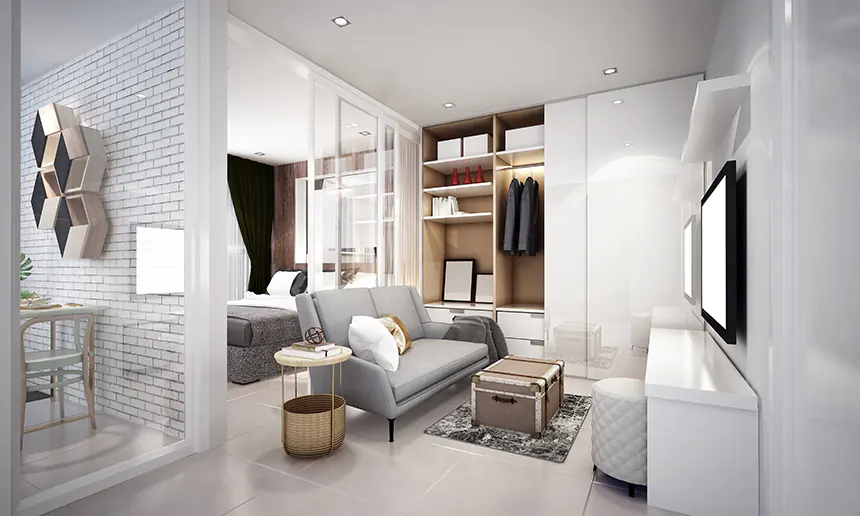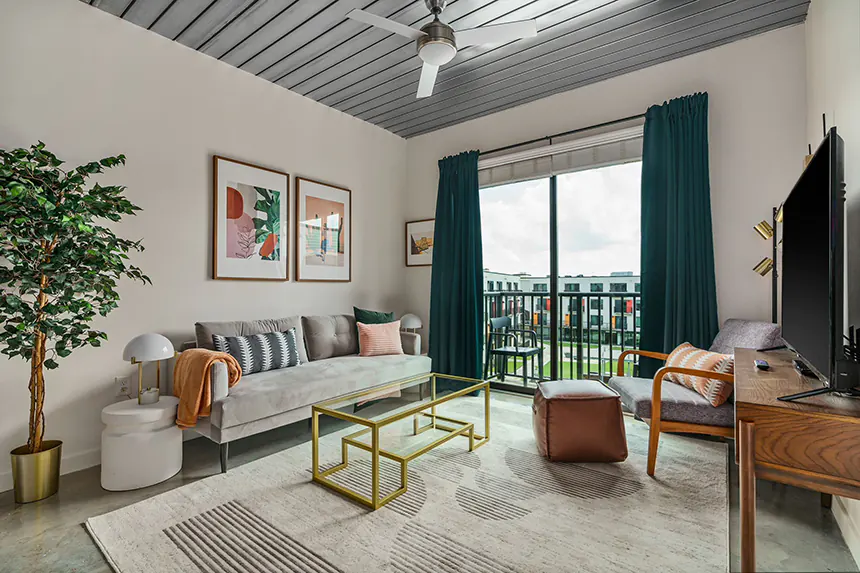
Is the multifamily industry ready to capitalize on the opportunity?
Long ago, nomadic hunters and gatherers sought out resources in new lands. Farmers, on the other hand, were tied to one location, much as modern workers became bound by the need to be close to their place of work or office.
In 2021, workers are shifting from a fixed-location lifestyle to a nomadic lifestyle at an unprecedented rate. “Digital nomads”, as they are called, can work from anywhere with an internet connection. Without the traditional fixed job location rooting them in one place, they are beginning to live nomadically. The rise of remote work has freed growing swaths of the economy from the constraint of living near an office.
Unfortunately, housing options still tend to tie people down. We think that needs to change. This article explores why multifamily operators should consider converting a portion of their inventory to furnished apartments and on-demand housing to take advantage of and adapt to changing behaviors and lifestyle.

There’s no denying COVID has transformed the way we work. With everybody staying home as much as possible, companies and employees alike who were nervous about remote work have discovered its many advantages.
However, in reality, COVID only accelerated what was already happening. In 2019, there were already over 26 million Americans — about 16% of the workforce— who worked remotely. Furthermore, in the 10 years between 2005 and 2015, remote work rose by 115%.
Now that so many people were forced into trying it, it’s unlikely the world will ever go back to the way it was before. The popularity of remote work is undeniable with 99% of remote workers saying they would like to continue working remotely, at least part-time, for the rest of their careers.
The benefits of remote work are also undeniable. Employees save time and money by not having to commute to work, maintain extensive work wardrobes, or buy lunch out every day. Businesses reduce their office and workspace costs while gaining access to larger talent pools. Cities are less congested with fewer people on the roads going to work. Although adjustments to a remote work environment require coordination between management and staff, most remote workers (77%) feel more productive at home.
Even though many positions will continue to require an employee’s physical presence, about 55% of businesses globally say they can offer some capacity for remote work. In other words, a lot of people are being freed up from being tied to a specific location for work.

However, mainstream housing options in the US do not typically provide the flexibility that digital nomads demand. Renters typically must sign at least a one-year lease for an apartment. Plus, that apartment will be empty, requiring them to move all their belongings, including heavy furniture, from one home to another when they want to move. Worse, if they’re setting up their first home, they’ll need to spend thousands of dollars even just for the bare essentials to make the apartment livable.
Overseas, renters commonly have more options and flexibility. Furnished apartments can be found on shorter lease terms, giving renters the ability to more easily move from place to place. In cities such as London in the UK, up to 82% of all rented accommodation is rented furnished. The expectation of a costly, time-consuming move is particular to the North American market.
Renting furnished apartments on flexible terms allows apartment owners to take advantage of another market subset as well. Americans have traditionally taken less vacation days, and thus had less opportunity to travel in the past. But flexible work arrangements mean that you don’t need to become a digital nomad to explore. Expect to see surging travel in the US, as the people can “work from anywhere”, even if it is just for a long weekend. And the accommodation they book is changing, greatly accelerated changes by COVID. Instead of staying primarily in hotels as they mostly did in the past, people and companies are booking homes. Airbnb may have captured the zeitgeist of the hotel alternative in cities, but this shift has been emerging over several decades with vacation rentals and corporate housing, and it’s not going to reverse after the pandemic.
Multifamily professionals can take advantage of this trend as well. Unlike leasing a bare apartment, furnished apartment inventory can be more flexibly rented, minimizing vacancy losses. You can not only attract long-term residents but monetize occupancy gaps by attracting demand from people who prefer to avoid hotels when traveling to enjoy the space and privacy of a luxury apartment.

Demand for convenience and flexibility is changing everything we do now. People are used to having exactly what they want on their terms. They don’t like constraints, hassles, or commitments.
Unfortunately, that’s exactly what most multifamily communities offer.
Multifamily property investing took a nose-dive in 2020. Investors were understandably nervous about what the future would look like. Renters were vacating apartments, especially in larger cities. No longer tied to an office, they sought more space to weather the lockdowns.
With interest rates so low, many renters took steps to become homeowners. If they were going to be stuck at home all the time now anyway, it made sense to purchase their own home. Instead of paying a premium for space in the city center when they couldn’t enjoy the amenities anyway, they might as well build equity in a home.
Though buying a home feels permanent, locking yourself into a one-year lease also has a semi-permanent feel. Life rarely fits neatly into 12-month blocks. Plus, hauling a home’s contents from one place to the next is a cumbersome slog. The cost, rigidity and effort of moving from an apartment to another made the jump from renting to buying a home much easier for renters, especially when they’d already purchased the furniture.
In Houston, our analysis shows vacancy rates rose to 15% in stabilized luxury communities in the Downtown and Midtown markets. That’s an average of 40 empty apartments per community, resulting in a million-dollar annual vacancy loss per building.
While we can point to oversupply and COVID as culprits, the reality is that there’s a product market-fit problem. By furnishing vacant apartments to create on-demand housing, multifamily communities can both diversify their revenue mix and make purchasing a home a less attractive option. Renters want the same convenience and flexibility in housing they get from entertainment, shopping, doctors, traveling and transportation.

With furnished apartments and on-demand housing, moving or setting up a home isn’t such a nightmare. Renters simply pack up their personal belongings, without having to worry about carting or buying furniture, home decor, and other cumbersome objects from one residence to the next. This lighter load makes moving faster, easier and cheaper.
Furthermore, with furnished, professionally decorated apartments, setting up a new place isn’t such a chore. You don’t have to disassemble furniture and reassemble it at the new place, praying you don’t lose any tiny but necessary screws or parts along the way. The bed is already made, and the kitchen is equipped. The utilities are connected, and the WiFi internet is configured. You also don’t have to spend days cleaning and organizing the new space. It’s already been done for you! There are no movers, stacks of boxes, or time lost searching for utility providers.
You can think of it like moving from one hotel to another, but for apartments.
Remote work, changes in travel trends, and demands for flexibility and convenience have accelerated the demand for on-demand housing. On-demand housing allows people to pack up and move out with minimal notice. Rather than signing leases for prescribed terms that do not align with their real-life plans, renters can use on-demand housing to tailor their housing start and end dates to a particular job contract, internship or other individualized need.
This sounds kind of scary for multifamily companies and investors. One of the reasons for using year-long leases is to ensure income for long periods of time and not having to spend so much time on marketing and finding new tenants. However, rising vacancy rates show this isn’t working. Even during COVID, data shows that converting vacant units to alternative accommodation can increase occupancy and even deliver above market rents, by tapping into short and mid-term rentals.
There’s a reason luxury apartments are sitting empty in so many cities right now: the uncertainties in today’s economy have reduced the market of people willing to lock themselves into a 12-month lease or incur the time and expense of moving.
Forward-thinkers and innovators are the ones who don’t just survive difficult times, they thrive through them. People are looking for flexible housing options — and ultimately are willing to pay for that convenience. Multifamily property operators have an opportunity to adapt their product offering in innovative ways and increase the value of their property. Once you start offering people what they’re really looking for, your vacant apartments fill themselves.
An edited version of this article appears in the May 2021 issue of the Houston Apartment Association’s ABODE magazine.
Lodgeur helps apartment operators boost their occupancy and NOI. We turn empty units into flexible furnished rentals and manage them to attract a new type of resident.
Find out more about partnering with Lodgeur.
